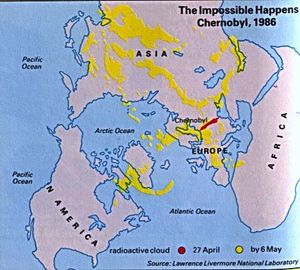
|
| ©Unknown |
| Chernobyl Facility |
Officials in Kiev yesterday said they had hired a French firm to replace the crumbling concrete sarcophagus that has stood at Chernobyl since 1986 - when it was the scene of the world's worst ever nuclear disaster.
The new shelter is an arch-shaped metal structure 105m (345ft) tall and 150m (490ft) long. It will enclose the sarcophagus hastily put up after the accident. That precarious structure has been leaking radiation for more than a decade.
"I am convinced that today, possibly for the first time, we can frankly tell the national and international community that the answer to the problem of sheltering the Chernobyl nuclear plant has been found," President Viktor Yushchenko said, according to his presidential website.
The European Bank for Reconstruction and Development has funded the $505m deal with a French construction firm, Novarka. The plan is to eventually dismantle the sarcophagus and the exploded reactor inside the new shelter.
According to official estimates, the reactor still contains about 95% of the original nuclear fuel from the plant. There are fears that if the sarcophagus collapses another cloud of lethal radioactive dust could escape.
Chernobyl's reactor No 4 exploded on April 26, 1986, spewing radiation over a large swath of the former Soviet Union and much of northern Europe. An area roughly half the size of Italy was contaminated, forcing the resettlement of hundreds of thousands of people.

|
| ©Lawrence Livermore National Laboratory |
| Path of radiation from Chernobyl explosion |
Anton Usov, a spokesman for the European Bank for Reconstruction and Development, said it will take about 1½ years to design the shelter and another four to build it.
Officials also signed a $200m contract with the US firm Holtec International to build a storage facility for spent nuclear fuel from the plant's three other reactors, which kept operating until the station was shut down in 2000.
"The successful implementation of the project depends not only on the progress of the construction work, but also on the continued commitment of both the Ukrainian authorities and the international community," the European bank's president, Jean Lemierre, said in a statement.
Within the first two months after the disaster, 31 people died from illnesses caused by radioactivity. But there is no consensus over the subsequent death toll. A 2005 report from the UN health agency estimated that about 9,300 people will die from cancers caused by Chernobyl's radiation. Some groups, such as Greenpeace, insist the toll could be 10 times higher.
Some 200,000 residents were evacuated from Ukraine alone.



Comment:
* Birth Defects: Five years after the disaster, the Ukrainian Ministry of Health reported three times the normal rate of deformities and developmental abnormalities in newborn children, as well as an increased number of miscarriages, premature births, and stillbirths.
* Other Cancers: Swiss Medical Weekly recently published findings showing a 40% increase in all kinds of cancers in Belarus between 1990 and 2000. (5) Tumor specialists fear that a variety of new cancers will only emerge 20-30 years after the disaster. (6) Cases of breast cancer doubled between 1988 and 1999.
* Other Diseases in Children: In addition to thyroid cancer and leukemia, UNICEF reports that between 1990 and 1994, nervous system disorders increased by 43%; cardiovascular diseases by 43%; bone and muscle disorders by 62%; and diabetes by 28%. UNICEF cautioned that it is difficult to prove whether these increases were caused by radiation or another unknown factor.
* Soil: Twenty-one percent of prime Belarusian farmland remains dangerously contaminated from the decaying components of plutonium.
* Groundwater: Radiation concentrated in sediments at the bottoms of lakes and ponds - the population continues to contaminate itself by fishing there. The average concentration of radionuclides in the groundwater has risen 10- to 100-fold.
* Food: The food and water supply is continuously contaminated by rainfall and by the movement of radioactive dust. Mushrooms - a national disk of Belarus - are severely contaminated in half the country but still collected and eaten. Livestock such as cattle and goats accumulate radioactivity in their meat and milk.
* Loss of a Culture: After the Chernobyl accident, almost 400,000 were forced to leave their homes for their own safety - homes and villages that had been part of their families for generations. Over 2,000 towns and villages were bulldozed to the ground, and hundreds more stand eerily silent.